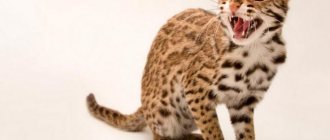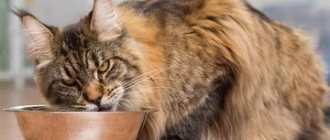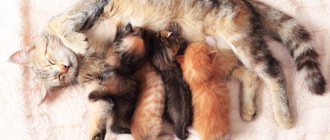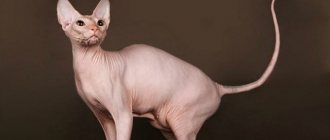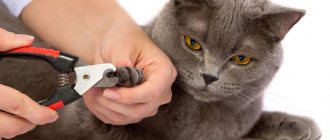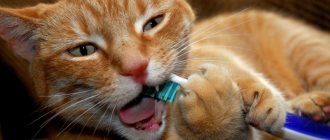08 April30496wild catscatpredator
Ocelot is a representative of the cat family, which is one of the most unusual and beautiful predators. At the same time, the ocelot cat is little studied. The ocelot animal is considered one of the brightest and most mysterious animals today. In this article you can see a description and photo of the ocelot, learn a lot of new and interesting things about the life of this exotic cat.
Attachment to family
In order for ocelots to live peacefully at home, they are accustomed to this from the age of 2-3 months. Adults are not completely tamed. Kittens raised by one owner from childhood become very attached to him and become faithful companions. They are affectionate, like ordinary cats, but if they don’t like something, they will immediately show dissatisfaction. No matter how gentle domesticated ocelots may seem, we should not forget that they are predators. Instincts cannot be completely suppressed, despite the attachment to the owners. The most famous owner of this breed was Salvador Dali. He even took his pet with him on trips.
Ocelot cats and kittens:
Details
External characteristics
Now the wild cat ocelot is an animal with a body of 55-100 centimeters, a tail length of 25-40 centimeters and a weight of 7-15 kilograms. Males are most often larger than females, but due to the wide range of sizes, it is sometimes difficult for a non-specialist to tell a female cat just by appearance. In general, this South American wild cat is very graceful, athletically built, with powerful limbs and a short tail relative to the body.
Naturalists have always been especially sensitive in their descriptions to the ocelot’s fur and color. Richard Lydekker noted that it is very difficult to describe the uniformity of the arrangement of stripes and curls in a species, because in each individual the rosettes, curls, stripes and spots are always located very specifically and cannot be systematized. In one description, all naturalists agreed with one voice - there are always several stripes that go from the scruff to the tail, all other patterns on the cat’s body are not stable.
Usually the main color of the coat is yellow, sand, sometimes ocher, but the markings, stripes and rosettes are always darker, ranging from brown to black. But the ocelot is not all striped, its belly and neck are white, and there are also white spots on the ears on their back surface. The hairs on the limbs and lower part of the body are 80 millimeters long, but on the back the hair grows 1 centimeter each. Also, the ocelot necessarily has a black eye rim, and the iris itself has the peculiarity of casting gold when exposed to sunlight. The nose protrudes on the muzzle and is pink or brown.
INTERESTING: in the wild the species lives up to 10 years, at home 15, but zoo ocelots can live up to 20 years.
Character traits and ability to live with a person
The ocelot cat breed as such does not exist, if you decide to get such a cat, then know that there is no particular point in looking for it at exhibitions, it is better to look for special nurseries where more than one generation of these wild cats has been raised as pets. It is easier to keep such ocelots in the house, since they already have some shifts towards domestication of the species.
In their natural habitat, ocelots live outside of pairs, coming together only during the rutting season. Typically, the habitat of the female is 15 square kilometers, and the male is 46 square kilometers. The period of activity is twilight and night. Wild ocelots treat their possessions very carefully, regularly marking their territory and dividing the entire space into areas for recreation, hunting and relief.
In the classical sense, an ocelot can never become a domestic cat. Firstly, it is impossible to keep such an animal in an apartment due to its size and its natural needs in a large area. Secondly, even castration does not save you from the urge to mark, so the best option for such an exotic cat is an enclosure. Yes, an ocelot may have access to the house, for example, through a special passage from the enclosure to the house, but the cat will still be more comfortable in a separate room.
The enclosure can consist of two sections - an open area with a tree and a pond and a semi-closed area with a canopy or house, and shelves for climbing. There must be toys in the enclosure, and it’s good if they are pet supplies for large dogs, since the ocelot will deal with ordinary cat balls and pompoms in a matter of minutes.
In a house where your ocelot will most likely come more often during the cold season, if he is not comfortable in a winter hutch, there should also be resting areas and a system of shelves and houses higher up to the ceiling.
INTERESTING: an ocelot can be trained to walk on a harness, but this must be done from early childhood, because an adult cat will not forgive you for this.
In matters of hygiene, the ocelot is able to take care of itself. It’s good if, while still a kitten, you teach him to comb and examine his eyes and ears for dirt, but in general, the ocelot itself is able to maintain its beauty and cleanliness if it eats well and the conditions of detention suit it.
The most difficult thing is providing decent nutrition. Even if you take an ocelot cat from a nursery, where this species is no longer wild and is accustomed to living with humans, it should still eat in its natural form. The ocelot will not eat any dry food under any circumstances, simply because it is not food for him.
The diet of a South American animal should consist of:
- Poultry or lean beef;
- Day old chicks;
- Rabbit meat;
- Special food mice (live);
- Fish (preferably live, but only if you are sure that there are no parasites in it);
- Quails (live).
Also, if there are lizards living on your property, which also foolishly climb into your cat’s enclosure, then don’t be surprised that he will definitely catch and eat them. He will do this not because he is hungry and lizards are tasty, but because it is in his natural nature.
The ocelot does not eat vegetables and fruits as such in nature, but in captivity it may fall in love with something specific, especially if it is gradually introduced to the products as a delicacy.
The ocelot is weakly attached to its family, and is especially intolerant of children and other animals. If you decide to get an ocelot, keep in mind that he will still forever remain a wild cat who will only become attached to you if you spend a lot of time with him, constantly play with him and feed him tasty and varied food.
IMPORTANT: if your ocelot constantly sits for a long time in the enclosure alone and sees you only when food is served, then do not be surprised that even an initially socialized kitten will eventually go wild again.
You should always monitor the health of a domestic ocelot together with a specialist, since in addition to mandatory vaccinations and regular deworming, it requires control just like a wild animal.
Ocelot character
From childhood, cats grow up very playful and at the same time they are very smart. Their behavior is similar to that of a domestic cat and a dog at the same time. They bring toys, walk on a leash, and swim in ponds. Like any other cat, the ocelot loves toys. This predator can be easily trained to use a tray.
The ocelot is not friendly with other pets , this is only possible if the ocelot kitten lives with another animal from birth. And then, such friendship is extremely rare.
Buying a kitten. The cost directly depends on the age, color, and pedigree of the baby. On average, the price of a kitten is from 2 to 4 thousand dollars .
To purchase, you should contact a specialized nursery and avoid purchasing an animal, which is called “from hand”. The nursery staff will give the buyer all the necessary information about the animal and will always provide assistance if necessary.
What does he look like?
Most of the animal’s body is golden in color, the belly is white or cream; and on top of this background there are spots in the form of various patterns! The spots are mostly black or dark brown, sometimes they join together to form chains or stripes located on the sides and back of the cat. The ocelot has two stripes on its cheeks and a stripe running from the top of its head. The eyes are framed by white fur. At the tip of the tail there are rings and dark stripes. The rest of the space is occupied by small dots and specks.
Ocelot length is from 73 to 100 cm, weight is from 6 to 12 kg. An ocelot lives about 14 years.
Appearance
The flexible, fit body of the ocelot reaches 50 centimeters at the withers and 100-120 in length. The cat's tail is quite short, up to 40 centimeters. The weight of one individual is from 10 to 16 kg. Males are traditionally larger than females . The powerful paws of the beast are ready to jump at any moment.
The fur of each ocelot wild cat has its own unique color. The thick, velvety fur is pleasant to the touch and decorated with patterns of rings and stripes in all shades of white, red, gold, brown, and black. The white belly and chin, round ears and huge brown eyes with oval pupils, outlined in a charcoal stripe, add charm. On the back of the ears there is a pattern reminiscent of eyes. Zoologists offer several versions. Some say that this helps babies follow the cat through dense thickets of bushes, others argue that the pattern is needed for protection from other predators.
Because of its skin, the cat suffered for a long time from the encroachments of hunters. Since the end of the 20th century, international trade in ocelot fur has been prohibited. This doesn't always stop poachers.
Behavior in the wild
The ocelot is native to America . It can be found on the territory of such states as:
- USA;
- Brazil;
- Ecuador;
- Peru;
- Argentina;
- Bolivia;
- Mexico and others.
Most often it lives in the thickets of tropical forests of the Amazon River basin. The wild cat is nocturnal. During the day it prefers to rest in the crown of trees, hollows or rock crevices. He swims well and climbs mountains without any problems. Ocelots are solitary and jealously guard their property. A cat allows only a female cat to enter its territory.
Ocelots are good hunters and ruthless killers . Sensitive hearing, developed sense of smell and acute vision leave victims no chance. The fangs bite into the prey and tear it apart. The animal has no chewing teeth. Small mammals, birds, and sometimes snakes and lizards become food.
Ocelots try to avoid larger relatives from the cat family: puma, jaguar. They have a similar range and can be dangerous and attack.
In their natural environment, ocelots breed all year round. A couple is created only to produce offspring . The mother takes care of the cubs and feeds one or two kittens with milk for several months. Young individuals leave their native nest when they are closer to 2 years old. The total lifespan in the wild is up to 15 years .
Social structure and reproduction
Photo: Ocelot kitten
Female ocelots become sexually mature around one and a half years, and males at two and a half years. These predators do not have a specific time frame for the mating season, but usually weddings take place more actively from June to October. Often, it is the females who are the first to start looking for gentlemen, meowing loudly and inviting suitors, who respond to the call with loud cries. The female strikes the male with her strong paws to force him to begin mating. The duration of pregnancy is about 80 days.
The expectant mother is actively preparing a shelter for her offspring. It can be located in a spacious hollow, a secluded cave, or simply in dense bushes. The female makes a soft bedding from her own wool, which she tears out from her abdomen. An ocelot can have from 1 to 4 cubs, but most often there are one or two. Kittens are born already in a fur coat, which is a darker shade than their parents, but they are completely blind, the weight of newborns reaches 250 grams. A caring mother cat treats them with her milk for three months. After about 3 weeks, the kittens' eyes open.
Interesting fact: some male ocelots help the female raise her offspring. They bring food to her den and guard her home from other predators.
Babies grow quite slowly and only when closer to three months of age do they first leave their shelter. Then the mother or both parents begin to drag small animals to the den, teaching the children to hunt, and soon they take the grown-up children with them in search of food, instilling in them all the necessary skills. The kittens live with their mother for a long time and only when they are closer to two years of age do they begin to look for their own territory for permanent residence.
Diet
Ocelots are carnivorous predators that in nature hunt a variety of small mammals; their diet includes armadillos, possums, rabbits, rodents, small birds, fish, large insects and reptiles.
According to studies by naturalists in the southeastern parts of Brazil, Ocelots mostly feed on primates, and the Mexican subspecies prefer iguanas.
Ocelots most often prey on animals weighing less than a kilogram. Therefore, they rarely attack large prey such as deer and peccaries, because a cat only needs 600-800 g of food daily to meet its energy needs.
The composition of the diet can vary significantly depending on the season and area of residence. Thus, in Venezuela, Ocelots prefer iguanas and rodents during the dry season, and then switch to land crabs during the rainy season.
Scientists believe that Ocelots are similar to their closest relatives in terms of food preferences, but the oncilla specializes more in arboreal marsupials and birds, while the margay is not so selective.
Ocelots, as established by naturalists, followed potential prey to capture prey, relying largely on their sense of smell. The animals are able to spend half an hour in ambush, and then, if the hunt does not take place, they move to a new observation site. They most often kill the prey immediately, and immediately pluck the feathers before eating the birds.
Behind the graceful and bright appearance of an elegant handsome man hides a cruel and merciless killer who, upon overtaking his prey, rips out its throat with one movement of his sharp fangs. The predator does not have chewing incisors, so it tears off pieces of meat and swallows them.
The animal chooses the time to hunt immediately after sunset. Unsurpassed hearing and excellent night vision helps Ocelot to successfully track prey at night in thickets of tall grasses and, more often, dense trees.
If it was not possible to get meat, then Ocelot will not remain hungry, he will come to the river and catch fish, lizards and snakes.
Features of home nutrition
The ocelot wild cat prefers to hunt small animals. The teeth of a predator are not suitable for chewing large pieces of meat. The ocelot swallows its prey whole. It attacks large animals only when it is very hungry.
The predator tracks prey from cover, pressing its body to the ground. Having overtaken the victim, it instantly kills with a bite to the neck. The predator eats small prey from the head, while large prey is eaten in parts, biting off small pieces. Predators prefer to hunt the following animals:
- Rabbits, marmots;
- Monkey;
- Field mice;
- Birds;
- Lizards;
- Snakes.
Ocelots are very fond of fish caught in shallow water. To maintain good physical shape, animals need 400-450 g of live meat per day. If there is not enough food, the cat does not disdain insects and lizards.
Facts: In nature, wild cats are solitary. Animals live together for some time only to mate.
A domestic predator needs to be fed 1-2 times a day. Access to food should be limited. It is good for your cat to feel hungry from time to time. It is advisable for adult predators to have a fasting day once a week.
The diet should include raw meat. Suitable for beef, veal, chicken, feed mice, rabbits. Pork is contraindicated for ocelots, because may cause illness. Meat at room temperature is served raw. Uneaten leftovers must be removed immediately.
Habitat
Dune cat (desert cat): description of the Arabian breed
The ocelot cat has a fairly extensive natural habitat. The largest number of individuals inhabits Central America, the other part of the natural habitat is South America. Depending on the habitat, it is customary to distinguish several subspecies of ocelot:
- pardalis - found near the Amazon River;
- aequatorialis - lives in the northern Andes;
- albescens - common in Mexico and Texas;
- maripensis - can be found in Venezuela or Guyana;
- mearnsi - distributed in Central American territories;
- mitis - lives in Argentina, occasionally found on the lands of the state of Paraguay;
- nelsoni - representative in Mexico;
- pseudopardalis - found in Colombia;
- puseaus - lives in Ecuador;
- steinbachi - common in Bolivia.
Important! To understand the size of a wild cat, it can be compared to a large breed dog. For example, the shepherd is comparable in size to this wild cat.
